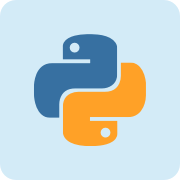Python参考手册
Python format 格式化函数
Python format 格式化函数
Python format 格式化函数

Python2.6 开始,新增了一种格式化字符串的函数 str.format(),它增强了字符串格式化的功能。
基本语法是通过 {} 和 : 来代替以前的 % 。
format 函数可以接受不限个参数,位置可以不按顺序。
实例
也可以设置参数:
实例
输出结果为:
网站名:非常教程, 地址 www.verydoc.net 网站名:非常教程, 地址 www.verydoc.net 网站名:非常教程, 地址 www.verydoc.net
也可以向 str.format() 传入对象:
实例
输出结果为:
value 为: 6
数字格式化
下表展示了 str.format() 格式化数字的多种方法:
>>> print("{:.2f}".format(3.1415926));
3.14
| 数字 | 格式 | 输出 | 描述 |
|---|---|---|---|
| 3.1415926 | {:.2f} | 3.14 | 保留小数点后两位 |
| 3.1415926 | {:+.2f} | +3.14 | 带符号保留小数点后两位 |
| -1 | {:+.2f} | -1.00 | 带符号保留小数点后两位 |
| 2.71828 | {:.0f} | 3 | 不带小数 |
| 5 | {:0>2d} | 05 | 数字补零 (填充左边, 宽度为2) |
| 5 | {:x<4d} | 5xxx | 数字补x (填充右边, 宽度为4) |
| 10 | {:x<4d} | 10xx | 数字补x (填充右边, 宽度为4) |
| 1000000 | {:,} | 1,000,000 | 以逗号分隔的数字格式 |
| 0.25 | {:.2%} | 25.00% | 百分比格式 |
| 1000000000 | {:.2e} | 1.00e+09 | 指数记法 |
| 13 | {:>10d} | 13 | 右对齐 (默认, 宽度为10) |
| 13 | {:<10d} | 13 | 左对齐 (宽度为10) |
| 13 | {:^10d} | 13 | 中间对齐 (宽度为10) |
| 11 | '{:b}'.format(11)
'{:d}'.format(11)
'{:o}'.format(11)
'{:x}'.format(11)
'{:#x}'.format(11)
'{:#X}'.format(11) |
1011 11 13 b 0xb 0XB |
进制 |
^, <, > 分别是居中、左对齐、右对齐,后面带宽度, : 号后面带填充的字符,只能是一个字符,不指定则默认是用空格填充。
+ 表示在正数前显示 +,负数前显示 -; (空格)表示在正数前加空格
b、d、o、x 分别是二进制、十进制、八进制、十六进制。
此外我们可以使用大括号 {} 来转义大括号,如下实例:
实例
输出结果为:
verydoc 对应的位置是 {0}

| Python format 格式化函数 |
|---|

Python 是一种面向对象的解释型计算机程序设计语言,由荷兰人 Guido van Rossum 于1989年发明,第一个公开发行版发行于1991年。 Python 是纯粹的自由软件, 源代码和解释器 CPython 遵循 GPL 协议。Python 语法简洁清晰,特色之一是强制用空白符( white space )作为语句缩进。
| 主页 | https://www.python.org/ |
| 源码 | https://github.com/python/cpython |
| 版本 | 2.7 |
| 发布版本 | 2.7.13 |
 加载中,请稍侯......
加载中,请稍侯......